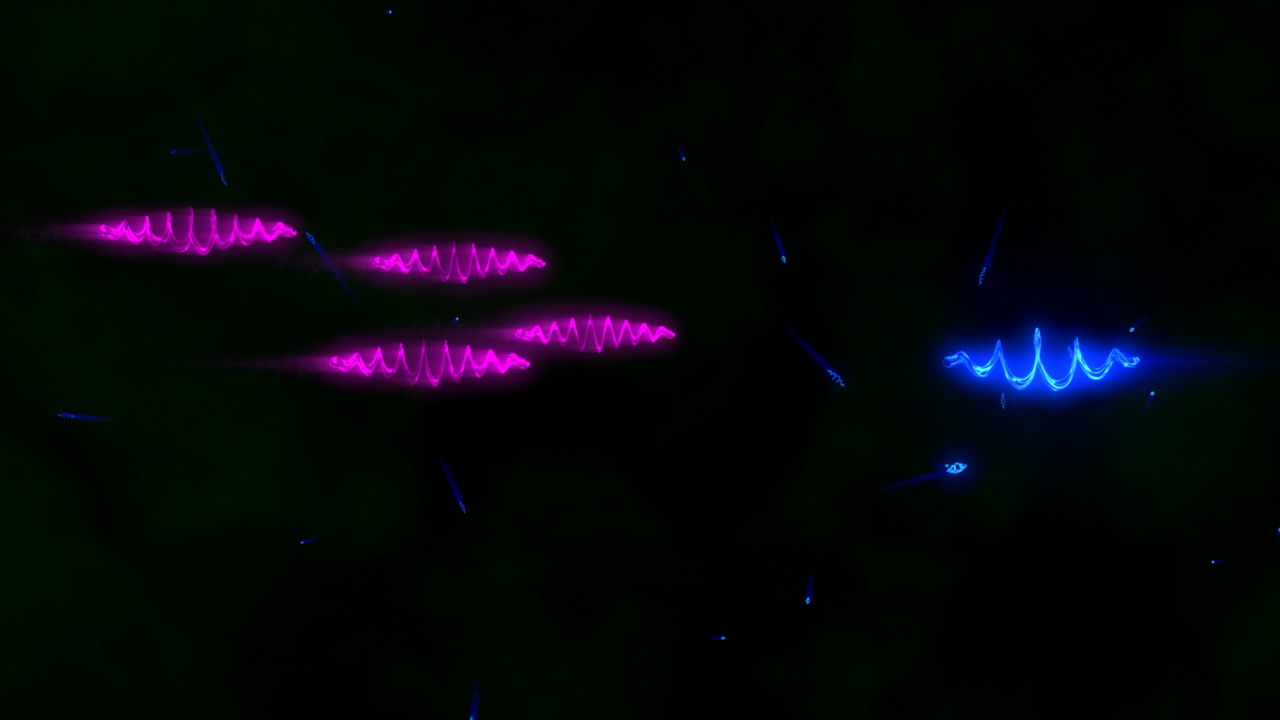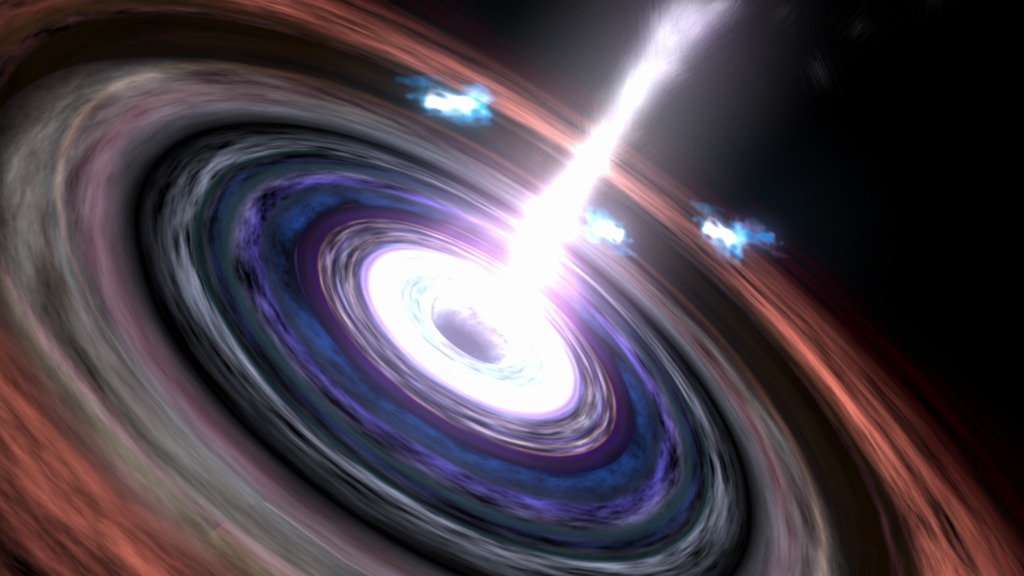NASA's Fermi Explores the Early Universe
Astronomers using data from NASA's Fermi Gamma-ray Space Telescope have made the most accurate measurement of starlight in the universe and used it to establish the total amount of light from all of the stars that have ever shone, accomplishing a primary mission goal.
Gamma rays are the most energetic form of light. Since Fermi's launch in 2008, its Large Area Telescope (LAT) observes the entire sky in high-energy gamma rays every three hours, creating the most detailed map of the universe ever known at these energies.
The total sum of starlight in the cosmos is known to astronomers as the extragalactic background light (EBL). To gamma rays, the EBL functions as a kind of cosmic fog. Ajello and his team investigated the EBL by studying gamma rays from 150 blazars, or galaxies powered by black holes, that were strongly detected at energies greater than 3 billion electron volts (GeV), or more than a billion times the energy of visible light.
As matter falls toward a galaxy's supermassive black hole, some of it is accelerated outward at almost the speed of light in jets pointed in opposite directions. When one of the jets happens to be aimed in the direction of Earth, the galaxy appears especially bright and is classified as a blazar.
Gamma rays produced in blazar jets travel across billions of light-years to Earth. During their journey, the gamma rays pass through an increasing fog of visible and ultraviolet light emitted by stars that formed throughout the history of the universe.
Occasionally, a gamma ray collides with starlight and transforms into a pair of particles — an electron and its antimatter counterpart, a positron. Once this occurs, the gamma ray light is lost. In effect, the process dampens the gamma-ray signal in much the same way as fog dims a distant lighthouse.
From studies of nearby blazars, scientists have determined how many gamma rays should be emitted at different energies. More distant blazars show fewer gamma rays at higher energies — especially above 25 GeV — thanks to absorption by the cosmic fog.
The farthest blazars are missing most of their higher-energy gamma rays.
The researchers then determined the average gamma-ray attenuation across three distance ranges between 9.6 billion years ago and today.
From this measurement, the scientists were able to estimate the fog's thickness. To account for the observations, the average stellar density in the cosmos is about 1.4 stars per 100 billion cubic light-years. To put this in another way, the average distance between stars in the universe is about 4,150 light-years.
See the media briefing page here.
This animation tracks several gamma rays through space and time, from their emission in the jet of a distant blazar to their arrival in Fermi's Large Area Telescope (LAT). During their journey, the number of randomly moving ultraviolet and optical photons (blue) increases as more and more stars are born in the universe. Eventually, one of the gamma rays encounters a photon of starlight and the gamma ray transforms into an electron and a positron. The remaining gamma-ray photons arrive at Fermi, interact with tungsten plates in the LAT, and produce the electrons and positrons whose paths through the detector allows astronomers to backtrack the gamma rays to their source.
This version has music and additional elements on it. For an animation-only version, go here.
Credit: NASA's Goddard Space Flight Center/Cruz deWilde
Watch this video on the NASAexplorer YouTube channel.
For complete transcript, click here.

Ultraviolet and visible light emitted by all the stars that ever existed is still coursing through the universe. Astronomers refer to this "fog" of starlight as the extragalactic background light (EBL).

Gamma rays interact with the EBL, which gives astronomers a means to probe the stellar content of the cosmos. When a gamma ray (magenta) strikes ultraviolet or visible light (blue), the photons are transformed into an electron and its antimatter counterpart, a positron. This process removes gamma rays from the spectra of bright sources like blazars. The degree of absorption increases for sources at greater distances.

This plot shows the locations of 150 blazars (green dots) used in the EBL study. The background map shows the entire sky and was constructed from four years of gamma rays with energies above 10 billion electron volts (GeV) detected by Fermi. The plane of our Milky Way galaxy runs along the middle of the plot. The Fermi LAT instrument is the first to detect more than 500 sources in this energy range.
Credit: NASA/DOE/Fermi LAT Collaboration

This plot shows the locations of 150 blazars used in the EBL study. The background map shows the entire sky and was constructed from four years of gamma rays with energies above 10 billion electron volts (GeV) detected by Fermi. The plane of our Milky Way galaxy runs along the middle of the plot. The Fermi LAT instrument is the first to detect more than 500 sources in this energy range.
Credit: NASA/DOE/Fermi LAT Collaboration

A foggy day at Duncansby Head Lighthouse on the northeastern tip of the Scottish mainland provides a useful analogy for the EBL measurements. The lighthouse is the blazar's gamma-ray emission, which must travel through the cosmic "fog" of starlight (photons of ultraviolet and visible light) before it reaches Fermi.
Credit:

Fermi measured the amount of gamma-ray absorption in blazar spectra produced by ultraviolet and visible starlight at three different epochs in the history of the universe.

This illustration places the Fermi measurements in perspective with other well-known features of cosmic history. Star formation reached a peak when the universe was about 3 billion years old and has been declining ever since.

The Fermi EBL measurements allow astronomers to constrain the number of stars that have ever shone in the universe. Moving forward, the measurements will serve as a guide for theoretical studies of the early universe, near the peak of star formation.
For More Information
Credits
Please give credit for this item to:
NASA/Goddard Space Flight Center. However, individual images should be credited as indicated above.
-
Animator
- Cruz deWilde (Avant Gravity)
-
Video editor
- Scott Wiessinger (USRA)
-
Producer
- Scott Wiessinger (USRA)
-
Science writer
- Francis Reddy (University of Maryland College Park)
-
Graphics
- Francis Reddy (University of Maryland College Park)
Release date
This page was originally published on Thursday, November 1, 2012.
This page was last updated on Wednesday, May 3, 2023 at 1:52 PM EDT.
Missions
This page is related to the following missions:Series
This page can be found in the following series:Tapes
The media on this page originally appeared on the following tapes:-
Fermi EBL Media Telecon
(ID: 2012104)
Thursday, November 1, 2012 at 4:00AM
Produced by - Robert Crippen (NASA)
Datasets used
-
[Fermi]
ID: 687
Note: While we identify the data sets used on this page, we do not store any further details, nor the data sets themselves on our site.

